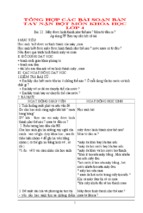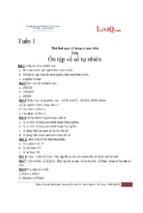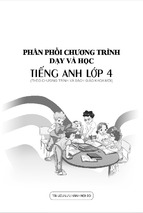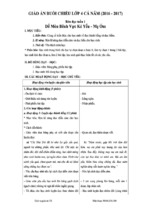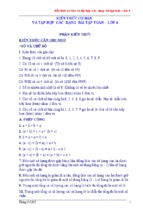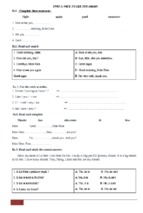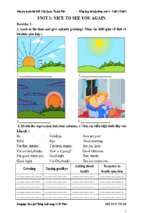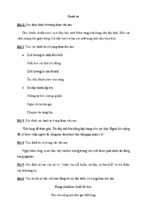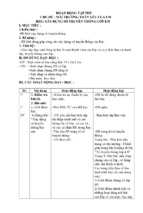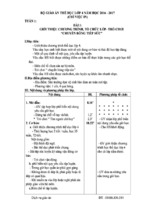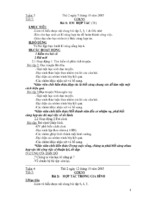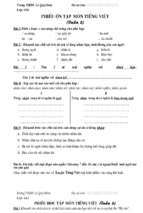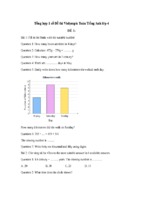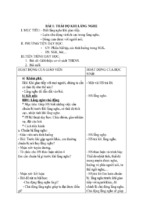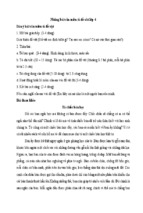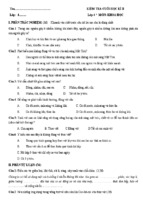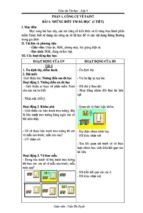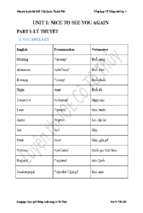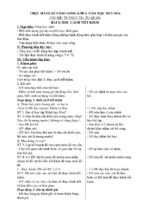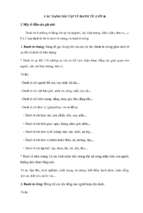Teaching date:
Week: 1
Period 1: UNIT 1: NICE TO SEE YOU AGAIN
LESSON 1(1-2-)
I. OBJECTIVES:
By the end of this lesson, Students will be able to say greeting eachother.
Phonics: Vocabulary: good morning, good afternoon, good evening, good
night, good bye.
Sentence patterns: A: Good morning, B
B: Good morning, A
Skills: Listening-reading-speaking-writing.
II. PREPARATIONS:
-Teacher: Books, extra-board, pictures
- Students: Books, pens, notebooks...
III. PROCEDURES:
Teacher's & Students’ activities
1. Warmer
*Check the total:
- Ask Ss to sing a song.
- Introduce smt about the theme
- Comment.
2. Presentation
*Act:
- Have Ss to look at the picture on 6 in part 1
ask them to identify the characters in the
picture. (How many parts? Who are there in the
picture? What are they doing in each picture?
- Let’s guess)
- Look at and identify the characters in the
pictures.
- Read the dialoguge 1 time
* Act1: Teaching newwords: (use the picture)
- Ask Ss to read in chorus.
- Call some Sts to read
- Read in chorus
- Use rub out and remember for checking the
words – Ss read without the new words
* Act2: Give new structure:
- Ask Ss to look at the conversation:
- Ask Sts to take example
- Guided Sts to read the dialogue in part 1
- Have some pairs to practise in fron of class,
other listen and comment
- Ask Ss to practice with the structures
1
Contents
Sing a song
1. Look, listen and repeat.
* New words:
+ good morning: Xin chào (buổi
sang)
+ good afternoon: Xin chào
(buổi chiều)
+ good evening: Xin chào (buổi
tối)
+ good night: Chỳc ngủ ngon
+ good bye: Tạm biệt
*Structures:
* Cách chào”
- Sentence patterns:
A: Good morning, B
B: Good morning, A
Eg: A: Good morning, boys
and girls
B: Good morning, Miss Hien
2. Point and say
- Greeting:
A: Good morning, B
B: Good morning, A
* Guid words:
3. Practice.
a. Mr Loc/ Nga/ good morning
3.1-Ask Ss to look the pictures on page 6 in ex b. Mr Green/ Mrs Brown/ good
2 to describe it
afternoon.
- Ss repeat all structures to greet in pairs.
c. Mrs Brown/ Mrs Green/ good
- Use the picture to ask Ss to speak.
evening.
- Take example for picture a
d. Miss Hien/ Linda/ goodbye.
- Give the form sentences and the picture,
Eg:
- Ss to give the miss words then speak aloud.
a. A: Good morning, Mr Loc
- Have some pairs to practice with each picture.
B: Good morning, Nga
- Some Ss practice, others listen and comment * Practice
- Have the whole class repeat
* The sentences form:
A: Good morning, B
4. Production
-Ask Ss to work in pair for greeting
B: Good morning, A
-Some pairs practice on front of class, othe
(pairs work)
comment.
5. Home work
- Learn by heart the new words and write
2times Nws. Do Exersices 1,2 inWork book
- Prepare: lessons 1(3-4) on page 7
______________________________________________________________
Teaching date:
Week: 1
Period 2: UNIT 1: NICE TO SEE YOU AGAIN
LESSON 1(3-4-5)
I. OBJECTIVES:
- By the end of this lesson, Students will be able to say greeting eachother.
- Phonics:
- Vocabulary: good morning, good afternoon, good evening, good night, good
bye.
- Sentence patterns: A: Good morning, B
B: Good morning, A
- Skills: Listening-reading-speaking-writing.
II. PREPARATIONS:
-Teacher: Books, extra-board, pictures
- Students: Books, pens, notebooks...
III. PROCEDURES:
Teacher's & Students’ activities
1.Warmer
*Check the total: 4A: / ; 4B /
* Check the old lesson:
- Ask some pairs to greet eachother with each
part of the day.
- Some pairs speak
- Comment.
2. Presentation
2
Contents
Eg:
a. A: Good morning, Lan
B: Good morning, Nga
b. A: Good afternoon, Long
B: Good afternoon, Nam
3. Listen and tick
*Act 1: Ask Ss to look the picture on page 7
to describe the pictures
- Guid Ss how to listen
- Ask Ss to look at and remark the pictures
- Play the tape and ask Ss to listen and tick
the picture is told in each sentence.
1. a. Miss Hien/Mai/ 8 a.m
b. Miss Hien/Nam/ 3 p.m
c. Miss Hien/Phong/ 7 p.m
2. a. Mr Loc/Phong/ morning
b. Mr Loc/Phong/ afternoon
c. Mr Loc/Phong/ evening
3. a. father/Mai/ morning
*Act2:
b. Mai/her friends/ afternoon
- Have Sts to look at the picture in ex 3c. Miss Hien/Mai afternoon
lesson1 and ask them to identify the names of * Result:
the persons in each picture and how to greet
1. b 2. a
3.a
in each parts of the day.
4. Look and write.
- Ss look at and identify the characters in
* Structure:
theses pictures.
1. Good……………
2. Good……………
3. Good……………
3. Practice.
*Guid words:
*Act 2: Ask Ss to read the poem in chorus
- morning
- Ss read in chorus.
- afternoon
- Help Ss sing the poem
- bye
- Ss listen and sing along.
*Keys:
- Call on some Ss to practise, other give idea 1. A: Good morning
- Help Ss sing .
2. A: Good afternoon,
- Give feed back:
3. A: Goodbye
4. Production
- Ask Ss to practice greeting eachothers using
structures they have just learnt.
- Ss work in pairs
- Call some pairs to practice.
- Some pairs speak
- Other group to listen and give ideas
*Practice:
A: Good..........., .......................
B: Good..........., .......................
5. Let’s sing:
* The song: Good morning to
you
Good morning to you.
Good morning to you.
Good morning to you dear Miss
Hien
Good morning to you.
5. Home work
- Do excersice: D
- Making sentences using strutures greeting in
each part of the day.
Good morning to you.
- Prepare: lessons 2(1,2) on page 8
Good morning to you.
Good morning to you dear
children
Good morning to you.
______________________________________________
3
Teaching date:
Week: 1
Period 3: UNIT 1: NICE TO SEE YOU AGAIN
LESSON 2(1-2-3)
I. OBJECTIVES:
- By the end of this lesson, Students will be able to listen and repeat how to
greeting to eachother.
- Phonics:
- Vocabulary: good morning, good afternoon, good evening, good night, good
bye.
- Sentence patterns: A: Good morning, B
B: Good morning, A
- Skills: Listening-reading-speaking-writing.
II. PREPARATIONS:
-Teacher: Books, extra-board, pictures
- Students: Books, pens, notebooks...
III.PROCEDURES:
Teacher's & Students’ activities
1.Warmer
*Check the total:
* Check the old lesson:
- Ask some pairs to greet eachother with each
part of the day.
- Some pairs speak
- Comment.
2. Presentation
*Act1:-Have Sts to look at the picture on page
8 in the part 1-lesson 2 and ask them to
identify the names of the persons in the
pictures and what they are doing.
- Ss look at and identify the characters in
these pictures.
- Guid Ss to look at, listen and repeat
- Ask Ss to listen and repeat.
- Ss listen and repeat
- Ask Ss to work in pairs
– Ss work in pairs read the dialogues
- Have some pairs to practise in fron of class,
other listen and comment.
– Ss practise in pairs
3. Practice.
-Ask Ss to look the picture on page 8 to
describe it
-Guided the Ss how to point and say
- Ss listen to the teacher
4
Contents
Eg:
a. A: Good morning, Lan
B: Good morning, Nga
b. A: Good afternoon, Long
B: Good afternoon, Nam
1. Look, listen and repeat:
*Structure: Greeting
A: Good..........., .......................
Nice to meet you
B: Good..........., .......................
Nice to meet you, too
2. Point and say:
*Structure: Saying goodbye
A: Good..........., .......................
See you tomorrow/ See you
later/
B: Good..........., .......................
See you tomorrow/ See you
later/
* keys:
a. A: Good bye, Miss Hien. See
you tomorrow
- Ask Ss to speak in pairs
- Ss work in pairs
- Ask Ss to play the role
- Ss speak in pairs
- Others remark and correct
- Give feed back
4. Production
-Ask Ss to review structure about greating and
saying goodbye
- Ss work in groups, reviewing
- Ask Ss to speak in groups
- Call some groups to practice.
- Some Ss speak
-Other group to listen and give idea
5. Home work
-Do excersice in work book.
- Making sentences using strutures in this
lesson
-Prepare the new lesson.
B: A: Good bye, Children. See
you tomorrow
b. A: Good bye, Mai. See you
later
B: A: Good bye, Linda. See
you later
c. A: Good bye, daddy and
mummy
B: A: Good bye,
3. Let’s talk
1. Greeting
A: Good..........., .......................
B: Good..........., .......................
2. Saying goodbye
A: Good..........., .......................
See you tomorrow/ See you
later/
B: Good..........., .......................
See you tomorrow/ See you
later/
__________________________________________________________________
Teaching date:
Week: 1
Period 4: UNIT 1: NICE TO SEE YOU AGAIN
Lesson 2 : Part 4,5,6
I. OBJECTIVES:
By the end of the lesson, students will be able to say and respond goodbye..
- Skills: Listening - Speaking
- Vocabulary: America
- Grammar : Revision the structures
II. PREPARATIONS: -Teacher: Books, extra-board, pictures
- Students: Books , pens, notebooks...
III. PROCEDURES:
Teacher’s and Students’ Activities
1.Warm up
Teacher greets students by greeting words they
have learnt:
2. Presentation
5
Content
Chatting
T: Hi. Good morning
everyone. How are you today?
Ss: Good morning teacher.
I’m fine thanks .And you?
T: fine, too.
- Ask students to look at the pictures in the
book and describe the pictures
3. Practice
4. Listen and number
- T asks students to open the book to page 9,
and then tell the greeting words in each picture. Key: a2 b4 c1 d3
Explain the task
- T asks students to guess before they listen
- T plays the tape and students listen, write the
numbers into the box
- Call some students say their answer. T
corrects
5. Look and write
- T asks students to look at the pictures and
then fill in the blank with suitable words in
pairs- Students do it
Key: 1. Viet Nam, Tom
- T calls some students go to the board and
2. Mr Loc, Good morning/
write down their answers
Hello/ Hi
- Others observe and comment. T corrects
3. Good night, Good night
- Teacher calls some students role play to check
students’ pronunciation.
4. Production
- Tell Ss that they are going to play the game * Let’s play
Bingo.
- Stick a large sheet of paper with the bingo Good
hello
Good
grid to the board.
morning
evening
- Tell them that there are nine words in the Bye
good
Good bye
grid.
night
- Ask them to draw a grid and put the nine Hey
Good
hi
words in the boxes in random order. Check
afternoo
comprehension.
n
- Call out the words, one at a time.
- Continue calling until there is a pupil getting
three words in a straight line crossed out and
calling Bingo!
5. Homework
- Review the content of lesson.
-Ask Ss to do exercises at home.
- Learn new words and structures, prepare for
the next lesson
_________________________________________________________________
Teaching date: 4A: Monday, August 25th 2015
Week: 2
4B: Monday, August 25th 2015
Period 5: UNIT 1: NICE TO SEE YOU AGAIN
6
Lesson 3: part 1-2-3
I. OBJECTIVES:
By the end of the lesson, students will be able to: Pronounce correctly the
sound of letter ‘l’ and “n”. - Give answers for question “How are you?”
.- Vocabulary: well, bored, happy, ok
- Grammar:
A: How are you?
B: I’m very well, thank you.
- Skills: writing, listening and speaking skills.
II. PREPARATIONS: -Teacher: Books, extra-board, pictures
- Students: Books , pens, notebooks...
III. PROCEDURES:
Teacher’s and Students’ Activities
1.Warm up
Divide class in to four groups and play it. Give
marks for group slap rightly and quickly
2. Presentation
*Act 1: Tell Ss that they are going to practise
saying the sounds of the letters l and n in the
words Linda and night respectively.
- Put the letters l and n on the board.
- Play the recording and ask Ss to repeat a few
times.
- Write the words Linda and night and the
sentences Hello, Linda and Goodnight on the
board
- Play the recording a few times and let Ss say
the words and phrases, paying attention to the
target sounds.
- Call Ss repeat again
3. Practice:
*Act 2: Tell Ss that they are going to listen to
the recording, circle the correct options and then
write the words in the blanks.
- Give them a few seconds to read the sentences
in silence and guess the words to fill the gaps.
- Play the recording more than once.
- Give Ss time to write the words in the gaps
independently.
- Have them swap their answers before
checking as a class.
- Ask Ss to read the sentences aloud.
4. Production
- Ask Ss to work i pair to greet and ask and
answer about the health.
7
Content
*Play game:
Slap the board
Good
afternoon
Good
morning
Nice to
meet you
1. Look, listen and repeat
l
Linda
n
night
Hello, Linda
Good night
2. Listen and circle. Then
write and say aloud.
Key: 1b 2b 3b 4a
* Practice:
A: Hello, B. How are you?
B: Hi, A. I’m very well, thank
you.
And you?
A. I’m Fine, thank you.
- Ss practice i pairs
- Ask some pair to speak
- Give feed back
5. Homework
- Review the content of lesson.
- Asks Ss to learn and write new words and
structure
- Learn new words and structures, prepare for
the next lesson
__________________________________________________________________
Teaching date: 4A: Tuesday, August 26th 2015
4B: Tuesday, August 26th 2015
Week: 1
Period 6: UNIT 1: NICE TO SEE YOU AGAIN
Lesson 3: part 3-4-5
I. OBJECTIVES:
By the end of the lesson, students will be able to: Pronounce correctly the
sound of letter ‘l’ and “n”. - Give answers for question “How are you?”
.- Vocabulary: well, bored, happy, ok
- Grammar:
A: How are you?
B: I’m very well, thank you.
- Skills: writing, listening and speaking skills.
II. PREPARATIONS: -Teacher: Books, extra-board, pictures
- Students: Books , pens, notebooks...
III. PROCEDURES:
Teacher’s and Students’ Activities
1.Warm up
Divide class in to four groups and play it.
Give marks for group slap rightly and
quickly
2. Presentation
*Act 1: - Tell Ss that they are going to read
the two texts and and answer the four
questions.
- Get Ss to read the first text and focus on
the information and answer the first two
questions. Then ask them to read the second
text and answer the last two questions.
- Give time to do the task independently.
- Have them swap their answers before
checking as a class.
3. Practice:
8
Content
* Slap the board
Good
afternoon
Good
Nice to
morning
meet you
4. Read and answer
Key: 1. Her name is Do Thuy Hoa
2. She’s from Ha Noi, Viet Nam.
3. His name is Tony Jones.
He’s from Sydney, Australia.
*Act 2:
- Tell Ss that they are going to write a short
paragraph about themselves.
- Have them work in pairs or groups to
discuss what they are going to write.
- Give time to do the task independently.
- Have them swap their answers before
checking as a class.
4. Production
*Act 3: - Teacher introduces the chant
-Play the tape. Ask students to read each
sentence in the chant
- Play the chant again and asks students to
read
- Ask students to read the chant, combine
with slap their hands.
-Divide class into groups to compete
together.
5. Homework
- Review the content of lesson.
- Asks Ss to learn and write new words and
structure
- Learn new words and structures, prepare
for the next lesson
5. Write about you
My name is……………….
I am from………………….
My school is………………
6. Let’s chant
Hello, I’m Linda
I’m from England
Nice to meet you, Linda.
Hello, I’m Nam
I’m from Viet Nam
Nice to meet you, Nam
Hello, I’m Linda
Hello, I’m Nam
We’re friends
_________________________________________________________________
Teaching date: 4A: Thursday, August 27th 2015
4B: Thursday, August 27th 2015
Week: 2
Period 7: UNIT 2: I’M FROM JAPAN
Lesson 1: part 1-2
I. OBJECTIVES:
- By the end of the lesson, sts will be able to ask and answer questions about where
someone is from, using Where are you from? I’m from.....
- Vocabulary: Japan, America, Australia, England, from, where
- Sentence pattern: Where are you from? I’m from .......
- Skills: Listening, writing, reading and speaking
II. PREPARATIONS: -Teacher: Books, extra-board, pictures
- Students: Books , pens, notebooks...
III. PROCEDURES:
Teacher’s and Students’ Activities
1.Warm up
- Have Ss play the game:
Noughts and Crosses
2. Presentation
9
Content
*. Play the game in groups.
- Ask Ss look at the four pictures and answer
- Play the recording twice for Ss to listen and
repeat.
3. Practice:
Have ss look at the picture and identify the
characters and what they are doing.
Elicit the new word and new sentence from
ss.
Teach the new word and new sentence.
Ask ss give some more examples.
Call a few pairs to act out the dialogue in
front of the class.
- Check as a class and correct pronunciation.
4. Production
- Get Ss to math each character with the
corresponding lines before they listen to the
song.
- Get Ss to read line of the lyrics.
- Play the recording all the way through.
- Ask Ss to do choral and individual
repetition of the song line by line.
- Have the class sing the song again and clap
their hands to reinforce the activity.
5. Homework
- practice singing on page 13
- Ask Ss to do Ex in Part ….(
- Learn new words and structures, prepare
for the next lesson
nice
how
It’s
evening
ok
again
well
later goodbye
1. Look, listen and repeat
Who are they in the picture?
What are they talking about?.
2. Point and say
* New words:
Japan
America
England
Singapore Australia China
* grammar:
Where are you from?
I am from Viet Nam
* Practice:
a. Hi. I’m....
Where are you from?
b. Hi, I’m.... I’m from ....
__________________________________________________________________
Teaching date: 4A: Friday, August 28th 2015
4B: Friday, August 28th 2015
Week: 2
Period 8: UNIT 2: I’M FROM JAPAN
Lesson 1: part 3-4-5
I. OBJECTIVES:
- By the end of the lesson, sts will be able to ask and answer questions about
where someone is from, using Where are you from? I’m from.....
- Vocabulary: Japan, America, Australia, England, from, where
- Sentence pattern: Where are you from? I’m from .......
- Skills: Listening, writing, reading and speaking
II. PREPARATIONS: -Teacher: Books, extra-board, pictures
- Students: Books , pens, notebooks...
III. PROCEDURES:
Teacher’s and Students’ Activities
10
Content
1.Warm up
- Have Ss play the game:
Noughts and Crosses
3. Point and say
* New words:
2. Presentation
- Have ss look at the picture and identify the
Japan
America
characters and what they are doing.
England
- Elicit the new word and new sentence from Singapore Australia China
ss.
* grammar:
- Teach the new word and new sentence.
Where are you from?
- Ask ss give some more examples.
I am from Viet Nam
- Call a few pairs to act out the dialogue in
* Practice:
front of the class.
a. Hi. I’m....
- Check as a class and correct pronunciation Where are you from?
b. Hi, I’m.... I’m from ....
3. Practice:
- Tel Ss that they are going to listen the three 4. Listen and tick
conversations and tick the correct pictures.
- Point to each picture and ask Ss questions
to check their comprehension.
Key: 1c 2b 3c
- Play the recording (x3) for Ss to listen and
tick.
- Have Ss to trade their answers in pairs.
- Ask a few questions to ensure their
comprehension for the listening text.
4. Production
- Get Ss to math each character with the
corresponding lines before they listen to the
song.
- Get Ss to read line of the lyrics.
5. Let’s sing
- Play the recording all the way through.
- Ask Ss to do choral and individual
repetition of the song line by line.
- Have the class sing the song again and clap
their hands to reinforce the activity.
5. Homework
- practice singing on page 13
- Ask Ss to do Ex in Part ….(
- Learn new words and structures, prepare
for the next lesson
11
Week: 3
_______________________________________
Teaching date: 4A: Tuesday, September 1st 2015
4B: Monday, August 31st 2015
Period 9: UNIT 2: I’M FROM JAPAN
Lesson 2: 1-2-3
I. OBJECTIVES:
- By the end of the lesson, sts will be able to ask and answer questions about
where someone is from, using Where are you from? I’m from.....
- Vocabulary: Japan, America, Australia, England, from, where
- Sentence pattern: Where are you from? I’m from .......
- Skills: Listening, writing, reading and speaking
II. PREPARATIONS: -Teacher: Books, extra-board, pictures
- Students: Books , pens, notebooks...
III. PROCEDURES:
Teacher's & Students’ activities
1. Warmer
*Check the total: 4A: / ; 4B /
* Check the old lesson:
- Ask some pairs to ask and answer where they
are from
- Some pairs speak
- Comment.
2. Presentation
*Act2:-Have Sts to look at the picture in the
part 1-lesson 2 and ask them to identify the
names of the persons in the pictures and what
does it means.
- Ss look at and identify the characters in
these pictures.
- Guid Ss to read the words with sounds (ese)
- Ask Ss to listen and repeat.
- Ss listen and repeat
- Ask Ss to work in pairs – Ss work in pairs
read the sentences
- Have some pairs to practise in front of class,
other listen and comment. – Ss practise in pairs
3.Practice.
-Ask Ss to look the picture on page 14 to
describe it
-Guided the Ss how to listen and number from
1 to 4.
- Ss listen and choose
12
Contents
Eg:
A: Where are you from?
B: I’m from ……………
1. Listen and repeat:
*Structure:
A: Where are you from?
B: I’m from ………………..
I’m …………...
eg: A: Where are you from?
B: I’m from Vietnam. I’m
Vietnamese.
2. Listen and number:
* Listening keys:
1. A: Where are you from?
B: I’m from London. I’m
English.
2. A: Where are you from?
B: I’m from Vietnam. I’m
Vietnamese.
3. A: Where are you from?
- Play the tape (twice), Ss listen and number to
B: I’m from Japan. I’m
the picture is told in each sentence.
Japanese.
- Ask Ss to share and exchange the results
4. A: Where are you from?
- Ss share in groups
B: I’m from Australia. I’m
- Ask Ss to give the results
Australian.
- Others remark and correct
* Keys: 1. b; 2. a; 3.d; 4.c
4. Production
-Ask Ss to say about the school, ask and
answer where they are from and which
*Practice:
nationalities they are
A: Where are you from?
- Ss work in groups
B: I’m from ………………..
-Call some group to practice.
I’m …………...
- Some Ss speak
-Other group to listen and give idea
5. Home work
- Do excersice in work book.
- Making sentences using strutures ask and
answer where they are from and which
nationalities they are
-Prepare the new lesson.
...............................................................................................................................
Teaching date: 4A: Wednesday, September 2nd 2015
Week: 3
4B: Tuesday, September 1st 2015
Period 10: UNIT 2: I’M FROM JAPAN
Lesson 2: 4,5,6
I. OBJECTIVES:
- By the end of the lesson, sts will be able to ask and answer questions about
where someone is from, using Where are you from? I’m from.....
- Vocabulary: Japan, America, Australia, England, from, where
- Sentence pattern: Where are you from? I’m from .......
- Skills: Listening, writing, reading and speaking
II. PREPARATIONS: -Teacher: Books, extra-board, pictures
- Students: Books , pens, notebooks...
III. PROCEDURES:
Teacher’s work
Students’ activities
1.Warmer
*Check the total: 4A: / ; 4B /
* Play game:
- Ask Ss to ask and answer where they come
from and what nationalities they are.
- Comment.
2.Presentation.
*Act 1: - Have Ss to look at the picture , ask
them to identify the characters in the picture.
-Ask Ss to read the letter and complete the
13
*Structure:
A: Where are you from?
B: I’m from ………………..
I’m …………...
3. Read and circle:
* New words:
+ dear: yờu quý
+ write soon: viết cho tụi sớm
sentences by circling the letter
-Ss read and tick the picture is told individually
- Ss work in pairs read and circle
- Call some Ss to read and give the answers,
others listen and comment.
-Give feedback and give the patterns sentences
-Have the whole class read each sentence in
chorus.
- Ss listen and repeat
- Ask some pairs to practice in front of class.
3.Practice.
*Act 2: Ask Ss to read the letter
- Ss listen and repeat.
- Help Ss practice ask and answer where they
come from and what nationalities they are.
- Ss work in pairs.
- Call on some Ss to practise, others give ideas
- Give feed back:
- Guide all class to practice themselves.
4.Production.
* Act 3: Guide Ss how to play.
- Ask Ss to play jumble words, which groups to
make the words in correct and speak aloud all
these words. which groups make more sentences
and quicker is the winner.
-Call some group to practice ask and answer
where they come from and what nationalities
they are, the others remark and correct
- Some Ss speak, Other group listen and give
idea
5.Home work.
-Makeing sentences ask and answer where they
come from and what nationalities they are.
-Do ex in work book, Preparation: Unit 2lesson 3
+ like: thớch
*Structure:
A: Where is he/she from?
B: he/she from ………………..
he/she …………...
* Key:
1. Akio is from Japan
2. She’s ten years old.
3. Her school is in Tokyo.
4. She likes swimming.
4. Let’s play:
Jumbled Letters
eg:
saanjpee
navitemees
lisegnh
usatliraa
*Structure:
A: Where is he/she from?
B: he/she from ………………..
he/she …………...
Teaching date: 4A: Thursday, September 3rd 2015
4B: Thursday, September 3rd 2015
Week: 3
Period 11: UNIT 2: I’M FROM JAPAN
Lesson 3: part 1-2-3
I. OBJECTIVES: After the lesson, students are able to:
- Pronounce correctly the sound of the letters “ j, v ”.
- Say what nationality they are.
- Listen and read for specific information.
14
- Skills: Listening and reading.
- Phonics: j, v
II. PREPARATIONS: 1. Teacher’s: student’s and teacher’s book, pictures,
cassette.
2. Students’: books, notebooks, workbooks.
III. PROCEDURES:
Teacher’s work
1. Warm up
- Have Ss play the game:
Slap the board.
Japane
se
Students’ activities
from
Malays
ia
2. Presentation:
*Act 1: - Let Ss pay attention to the letters
coloured differently.
- Have Ss learn to produce the sound of the
letters “ J, V” in the words Vietnamese, Japan
- Play the tape and ask Ss to listen.
- Play the tape again and ask Ss to repeat each
line of the text in chorus.
- Have Ss read in groups/ in pairs.
3. Practice:
*Act 2: - Have Ss look at the words in part 2 (p.
16) to identify where they are and set up the
task.
- Play the recording 2 times pupils to listen and
tick the boxes.
- Play the recording again pupils check their
answers.
- Check and correct.
- Have some ss retell.
4. Production:
*Act 3 :
T guides Ss how to do the exercise.
-Ask students to read the text 1, 2 in the book
and fill the words given to complete the table.
Correct the pronunciation.
Answer: Tony: Sydney/Australia/Australian
Linda: Lodon/ England/ English
Tom: Newyork/ America/American
5. homelink:
- Ask Ss to do exercises in C, D (p.6/WB) at
home.
15
- Work in groups to play the
game.
Japan
Malaysi
an
1. Listen and repeat.
- Identify: Japan, Vietnamese
- Pay attention.
- Listen.
- Listen and repeat.
- Read in groups./ in pairs.
2. Listen and tick.
- Look and read the words.
- Guess the answer
- Listen and tick the words
they hear. Check their guess.
Compare the answer with the
partner.
1.a
2. b
3. Read and complete
- Read the text individually
and do the task.
- Check in peers.
- One reports the answer. The
rest of the class listen and
give comments.
- Do at home.
Teaching date: 4A: Friday, September 4th 2015
4B: Friday, September 4th 2015
Week: 3
Period 12: UNIT 2: I’M FROM JAPAN
Lesson 3: part 4-5-6
I. OBJECTIVES: After the lesson, students are able to:
- Say what nationality they are.
- Listen and read for specific information.
- Skills: Listening and writing.
- Sentence: the same l1,2
- Grammar: the same l1,2
II. PREPARATIONS:
1. Teacher’s: student’s and teacher’s book, pictures, cassette.
2. Students’: books, notebooks, workbooks.
III. PROCEDURES:
Teacher’s work
Students’ activities
1. Warm up
- Have ss play the game: Jumbled letters.
+ Show ss words in which all the letters have
got mixed up.
+ Have ss put the letters in the correct order to
make a word.
+ Call ss to give the answer.
- Have ss read aloud all words.
2. Presentation:
- Have pupils look at pictures a, b, c and d on
page of the Student Book. Elicit the
identification of the characters in the pictures and
the characters’ words. Tell pupils that they are
going to listen to the recording and number the
pictures they hear.
- Play the recording 2 times pupils to listen and
number the boxes.
- Play the recording again pupils check their
answers. T give the answer.
- Ask some questions to ensure pupils’
comprehension of the listening text.
3. Practice:
- Have pupils look at the sentences and guess the
suitable words to fill.
- Call on some Ss to report the answers .
- Guide ss to complete the exercise.
- Have ss read aloud the words they have written.
- Check and correct.
4. Production:
16
- Play the game:
layMsiana
Malaysian
Vienatmees Vietnamese
Jpaesean
Japanese
Amrieacn
American
- Read in chorus.
4. Listen and number.
- Indentify the characters in
each picture
- Guess the answer
- Listen and number. Check
their guess. Compare the
answer with the partner.
Pupils check their answers.
- Listen and check their
answer
Answer: 1.c 2. b 3.d 4.a
5. Look and write
- Look at the sentences and
guess the suitable words to
fill.
- Some Ss reports the answer.
5. Let’s write
- Complete the excercise
- Have Ss look at the sentences.
- Guide Ss to write about their names, country,
nationality.
- Call on some students to report the answers to
the class.
- Check and correct.
5. homelink:
- Ask Ss to do Ex in the workbook.
individually.
- 7-8 Ss read aloud, others
listen and give comment.
- Read in pairs.
- Complete the excercise
individually.
- Report the answers to the
class and give comments.
__________________________________________________________________
Week: 4
Teaching date: 4A: Tuesday, September 8th 2015
4B: Monday, September 7th 2015
Period 13: Unit 3: WHAT’S DAY IS IT TODAY?
Lesson 1( 1-2-3)
I. OBJECTIVES: After the lesson Ss will be able to:
- Ask and answer questions about days of the week.
- Listen for specific information.
- Skills: speaking, listening.
- Vocabulary: Monday, Tuesday, Wednesday,Thursday, Friday, Saturday, Sunday.
- Sentence patterns: - What day is it today? - It is Monday.
II. PREPARATIONS:
1. Teacher’s: student’s and teacher’s book, pictures,
cassette.
2. Students’: books, notebooks, workbooks.
III. PROCEDURES:
Teacher’s work
1. Warm up: - Say chattings.
*Check the total: 4A: /
; 4B: /
* Check the old lesson: Have pupils
asking and answering about their
nationality
2. Presentation:
*Act 1: Have ss look at the picture &
identify the characters and what they are
doing.
- Introduce the dialogue: They are going
to listen to children & Miss Hien talking
about days of the week.
- Play the CD for the ss.
- Play again, have ss listen and repeat,
focus on some words.
- Present the way to ask questions about
days of the week.
- Have ss read the dialogue.
- Check some groups.
17
Students’ activities
- Respond
1. Look , listen and repeat
- Identify the characters.
- Look and Listen.
- Listen and repeat.
- Listen and repeat. Pay attention to
day, today, Monday.
- Listen and note down:
- What day is it today? -It is Monday.
- Read and check.
- Identify.
3. Practice:
*Act 2:
- Have ss look at the picture and
identify days of the week.
- Give the meaning of new words.
- Have ss practice reading new words.
- Call some ss to read.
- Do the task with a student and then
have ss work in pair ask and answer
about days of the week.
- Check ss.
4. Production:
*Act 4: - Have Ss look at the pictures in
N 4 to identify days of the week.
- Ask Ss to listen and tick.
- Have ss listen again and check.
- Call on some students to report the
answers to the class.
- Check and correct.
5. Homelink:
- Have ss play the game: Matching.
- Ask Ss to do A,B at home.
2. Point and say
- Note down.
Monday Tuesday
Wednesday
Thursday Friday Saturday Sunday
- Read in chorus.
- Read before the class.
- Practice speaking.
- What day is it today? - It is .....
- Act it out and correct.
- Identify.
-Listen and do the task.
- Listen and check.
- Practice in pairs.
3 . Listen and tick.
- Give out and check: 1a; 2a; 3b;
- Look and match:
Monday
Chủ nhật
Friday
Thứ sỏu
Thursday
Thứ bảy
Saturday
Thứ hai
Sunday
Thứ ba
Wednesday Thứ năm
Tuesday
Thứ tư
- Do at home.
_________________________________________________
Teaching date: 4A: Wednesday, September 9th 2015
Week: 4
4B: Tuesday, September 8th 2015
Period 14: Unit 3: WHAT’S DAY IS IT TODAY?
Lesson 1 (4,5,6)
I. OBJECTIVES: After the lesson Ss will be able to:
- Ask and answer questions about days of the week.
- Listen for specific information.
- Skills: speaking, listening.
- Vocabulary: Monday, Tuesday, Wednesday,Thursday, Friday, Saturday, Sunday.
- Sentence patterns: - What day is it today? - It is Monday.
II. PREPARATIONS:
1. Teacher’s: student’s and teacher’s book, pictures,
cassette.
2. Students’: books, notebooks, workbooks.
III. PROCEDURES:
Teacher’s & Students’ activities
1. Warm up:
*Check the total: 4A: /
; 4B: /
- Have ss sing the song on page 19.
Contents
- Sing in chorus.
- Give out and check.
18
* Check the old lesson:
- Call some ss to sing.
- Check.
3 . Listen and tick.
1. a. Monday
2. Presentation:
*Act 1: - Have pupils look at pictures a, b,
b. Thursday
c on page 19 of the Student Book. Tell
c. Tuesday
pupils that they are going to listen to the 2. a. Tuesday
recording and tick the pictures they hear.
b. Thursday
- Ss look at pictures a, b, c on the page 19.
c. Friday
Elicit the identification of the characters in
3. a. Saturday
the pictures and the characters’ words
b. Friday
- Guess the answers
c. Wednesday
- Play the recording 2 times pupils to listen * Answer key;
and tick the boxes.
1.
; 2.
; 3.
- Ss Listen and tick. Check their guess.
- Ss Compare the answers with the partner. 5. Look and write:
- Play the recording again pupils check their * Word cues:
answers. T give the answer.
Nam’s acivities page 19
- Listen and check their answer
Student’sbook
- Ask some questions to ensure pupils’ * The answers:
comprehension of the listening text.
1. Today is Monday. I play
football today.
3. Practice:
*Act 2: Have pupils look at the sentences
2. Today is Tuesday. I watch TV
and the table (p19).
today.
- Guide ss to complete the exercise.
3. Today is Saturday. I visit my
Ss look at the sentences and the table (p19) grandparents today.
to find the suitable words to fill in the 4. Today is Sunday. I go to the zoo
blanks.
today.
- Call on some Ss to report the answers .
- Have ss read aloud the sentences they have
written.
6. Let’s sing:
- Check and correct.
The song”We have English
4. Production:
today” in the book page 19
*Act 3: Guide Ss how to sing
- Ss look at and listen
- Help Ss sing sentence by sentence
- Ss listen and sing along
- Ask Ss to listen to the song and sing along
- Ss listen and sing along
- Call some Ss to sing
5. Homelink:
- Ask Ss to do Ex in Part E.
- Prepare the new lesson.
_________________
19
Teaching date: 4A: Thursday, September 9th 2015
4B: Thursday, September 9th 2015
Period 15: Unit 3: WHAT’S DAY IS IT TODAY?
Lesson 2( 1-2-3)
I. OBJECTIVES: After the lesson Ss will be able to:
- Ask and answer questions about days of the week. And what you do everyday on
each day of the week.
- Listen for specific information.
- Skills: speaking, listening. And writing skills
- Vocabulary: help; parents; go to the zoo; play the guitar;
- Sentence patterns: - What do you often do on___________?
I___________in the morning/ I___________ in the afternoon.
II. PREPARATIONS:
1. Teacher’s: student’s and teacher’s book, pictures,
cassette.
2. Students’: books, notebooks, workbooks.
Week: 4
III. PROCEDURES:
Teacher’s work &Students’ activities
1. Warm up: - Say chattings.
*Check the total: 4A: /
; 4B: /
* Check the old lesson: Have pupils asking
and answering about the date doday
2. Presentation:
*Act 1: Have ss look at the picture & identify
the characters and what they are doing.
- Introduce the dialogue: They are going to
listen to children are talking about days of the
week.
- Play the CD for the ss.
- Play again, have ss listen and repeat, focus on
some words.
- Present the way to ask questions about what
they do in each day of the week.
- Have ss read the dialogue.
- Check some groups.
3. Practice:
*Act 2:
- Have ss look at the picture and identify days
of the week and the activities they do in the
morning ad afternoon in eah day.
- Give the meaning of new words.
- Have ss practice reading new words.
- Ask Ss to work in pairs ask and answer
about what they do in the morning and
afternoon in each day. Call some ss to read.
- Do the task with a student and then
20
Contents
A: What day is it today?
B: It is Monday.
1. Look , listen and repeat
help;
Giỳp
parents;
Cha mẹ
go to the zoo; Đi thăm sở
play the
thỳ
guitar;
Chơi đàn ghi
ta
* Structure: Ask and answer
about what they do everyday
A: What do you often do
on______?
B: I_________in the morning.
I_________ in the afternoon.
2. Point and say
* Structure: Ask and answer
about what they do everyday
A: What do you often do
on______?
B: I_________in the morning.
I_________ in the afternoon.
* The guide in the book page
20
Eg:
- Xem thêm -

